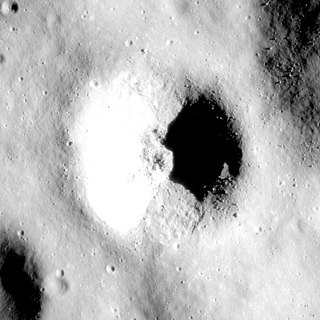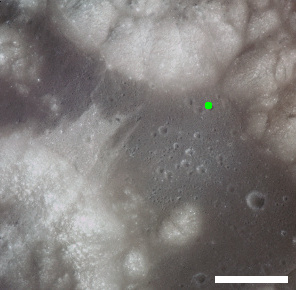
Alphonsus is an ancient impact crater on the Moon that dates from the pre-Nectarian era. It is located on the lunar highlands on the eastern end of Mare Nubium, west of the Imbrian Highlands, and slightly overlaps the crater Ptolemaeus to the north. To the southwest is the smaller Alpetragius. The crater name was approved by the IAU in 1935.

Copernicus is a lunar impact crater located in eastern Oceanus Procellarum. It was named after the astronomer Nicolaus Copernicus. It typifies craters that formed during the Copernican period in that it has a prominent ray system. It may have been created by debris from the breakup of the parent body of asteroid 495 Eulalia 800 million years ago.

Aldrin is a small impact crater located on the southern part of the Mare Tranquillitatis, to the east of Sabine. It is located about 50 kilometers to the northwest of the Apollo 11 landing site, Tranquility Base. Named after Buzz Aldrin, the crater is the westernmost of a row of three craters named in honor of the Apollo 11 crew members. About 30 kilometers to the east is the landing site of the Surveyor 5 lunar probe.

Collins is a tiny lunar impact crater located on the southern part of the Mare Tranquillitatis. It is located about 25 kilometers to the north of the Apollo 11 landing site, Tranquility Base. Named after American astronaut Michael Collins, the crater is the central member of the row of three craters named in honor of the Apollo 11 crew members. About 15 kilometers to the west-northwest is the landing site of the Surveyor 5 lunar probe.

Moltke is a lunar impact crater near the southern edge of the Mare Tranquillitatis. It is a small, bowl-shaped crater surrounded by a bright halo of higher-albedo material. Just to the south lies the rille system named Rimae Hypatia. These follow a course running roughly east-southeast to west-northwest, and have a length of approximately 180 kilometers.

Humboldt is a large lunar impact crater that is located near the eastern limb of the Moon. Due to foreshortening this formation has an extremely oblong appearance. The actual shape of the crater is an irregular circle, with a significant indentation along the southeastern rim where the prominent crater Barnard intrudes. To the north-northwest of Humboldt is the large crater Hecataeus. Phillips is attached to the western rim. The rim of Humboldt is low, worn, and irregular in outline. The central peak forms a range on the crater floor. The floor surface contains a network of rilles forming a pattern of radial spokes and concentric arcs. There are also some dark patches located near the walls to the northeast, northwest, and southeast. There is a chain of craters leading from the northwest crater rim to a distance almost as long as the crater is wide. This formation is designated Catena Humboldt. Due to its location near the lunar limb, little detail was known about this crater until it was photographed by orbiting spacecraft.

Proclus is a young lunar impact crater located to the west of the Mare Crisium, on the east shore of the Palus Somni. Its diameter is 27 km. It was named after 5th century Greek mathematician, astronomer and philosopher Proclus.

Lansberg is a lunar impact crater on the Mare Insularum. It can be located by following a line south-southwest from Copernicus to Reinhold, then southwest to Lansberg. The crater has a high rim and a central mountain. There are terraces along the inner walls, and the tops have slumped to produce a sharp edge. This formation is not noticeably eroded, and there are no significant impact craters within the interior.

Dollond is a small lunar impact crater that is located in the central region of the Moon, to the north of the crater Abulfeda. It was named after British optician John Dollond. Due west of Dollond is Anděl. Dollond is circular and cone shaped, with a tiny floor at the midpoint of the sloping interior walls.

Ewen Adair Whitaker was a British-born astronomer who specialized in lunar studies. During World War II he was engaged in quality control for the lead sheathing of hollow cables strung under the English Channel as part of the "Pipe Line Under The Ocean" Project (PLUTO) to supply gasoline to Allied military vehicles in France. After the war, he obtained a position at the Royal Greenwich Observatory working on the UV spectra of stars, but became interested in lunar studies. As a sideline, Whitaker drew and published the first accurate chart of the South Polar area of the Moon in 1954, and served as director of the Lunar Section of the British Astronomical Association.

North Ray crater is a small crater in the Descartes Highlands of the Moon visited by the astronauts of Apollo 16. The name of the crater was formally adopted by the IAU in 1973. It is the largest crater sampled by astronauts during the Apollo program.

Cochise is a feature on Earth's Moon, a crater in Taurus-Littrow valley. Astronauts Eugene Cernan and Harrison Schmitt landed southwest of it in 1972, on the Apollo 17 mission. They drove along its rim in the rover during EVA 3, but did not stop.

Little West is a small crater in Mare Tranquillitatis on the Moon, east of the Apollo 11 landing site known as Tranquility Base.
The following outline is provided as an overview of and topical guide to the Moon:

Surveyor crater is a small crater in Oceanus Procellarum on the Moon. The name of the crater was formally adopted by the IAU in 1973.

Head crater is a small crater in Oceanus Procellarum on the Moon. The name of the crater was formally adopted by the IAU in 1973.

Bench crater is a small crater in Oceanus Procellarum on the Moon. The name of the crater was formally adopted by the IAU in 1973.

Sharp-Apollo crater is a small crater in Oceanus Procellarum on the Moon. The name of the crater was formally adopted by the IAU in 1973.

Cone crater is a small crater in the Fra Mauro highlands, north of Fra Mauro crater, on the Moon. The name of the crater was formally adopted by the IAU in 1973.

Middle Crescent crater is a small crater in Oceanus Procellarum on the Moon. The name of the crater was formally adopted by the IAU in 1973.




















